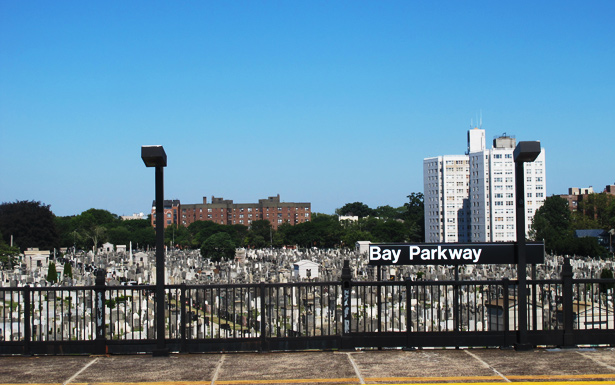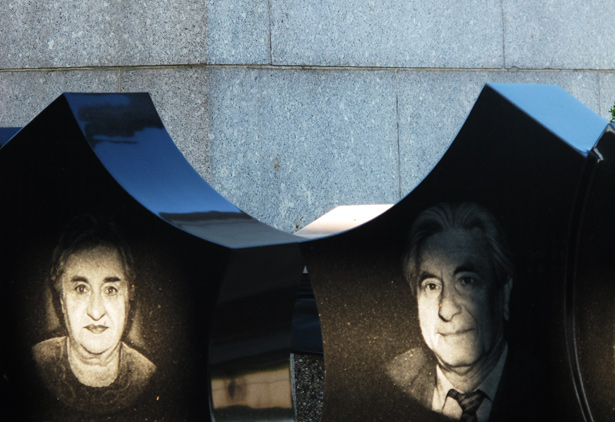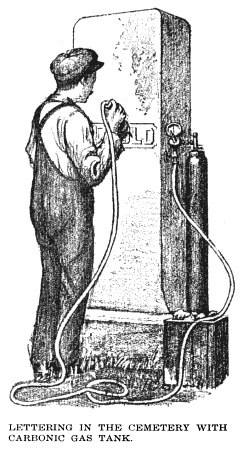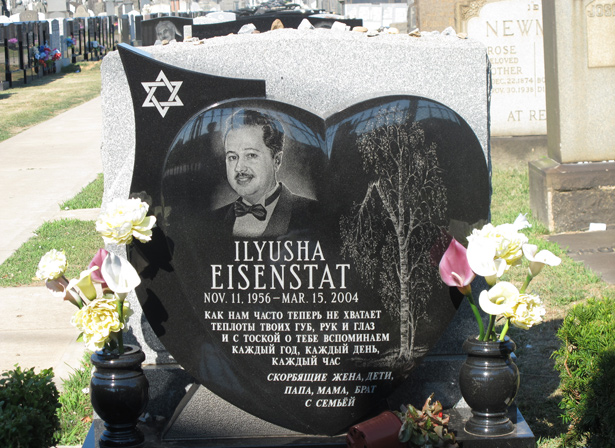Using a Laser to Read Old Gravestones
Lasers for the Dead: A Story About Gravestone Engineering

BROOKLYN -- Nosotros hopped on the F line in Carroll Gardens, but not in the normal management, north to Manhattan. Instead we headed s, out towards Gravesend. The railroad train rattled through the long stretches of Brooklyn where immigrants and the formerly hip have families and abound up and one-time. Each end looked like the one earlier information technology.
And then, the doors opened at Bay Parkway.The elevated train tracks bisected a cemetery. Gravestones surrounded united states of america. We could see where tens of thousands of people had been laid to residue. We had known we were going to a graveyard, just this one seemed improbable and indelicate. Industrial.
My fiancée'due south keen grandmother's century-old headstone was out in that location somewhere among the bounding main of granites marking the graves of European Jews who had been lucky enough to receive a proper burial. We'd come up to see it, but nosotros walked down the stairs of the platform and right into a sign that told usa nosotros were likewise late; the place was closed. We hung around the archway peering in at the rows of memorials, so decided to walk effectually the perimeter, seeing equally nosotros'd already made the trip.
As we circumnavigated the plots, nosotros began to see a design. Shiny, black headstones lined vast tracts of lighter grey headstones "almost like stitching," Sarah observed. These headstones were dissimilar from the ones that had come before them. Non simply were they a unlike color and texture, they also featured photorealistic portraits of the people buried underneath them. They were a new breed of monument. One look at them could have told you lot that no human being manus had chiseled those drawings in the stone.
At some point in the not too afar past--our initial investigation pointed to the last decade of the millennium--the way people marked the graves of their loved ones in this cemetery changed. And after that, for the remainder of the time civilized humans observe such things, the difference will exist apparent. Time to come archaeologists will be able to deduce when civilization had advanced to applying low-cal distension by simulated electromagnetic radiation to their eternity-invoking rites for the expressionless.
Lasers had arrived in the death industry.
* * *
Lasers were 1 of those miracle inventions of the mid-century, when progress seemed assured. Offset adult in 1960, it wasn't until the next decade that they found their defining and inglorious early on job: cut canvass metal. From there, they began to exist incorporated into all kinds of industrial processes. And then, xxx afterwards they appeared, a minor Fitchburg, Massachusetts company, Vytek, a subsidiary of Vinyl Technologies, decided that lasers could be used to make a amend gravestone.
In 1989, Vytek began to sell laser systems specifically to the monument industry that could take a photograph or drawing and reproduce information technology on granite. The light amplification by stimulated emission of radiation works almost like a printer, simply instead of putting nighttime ink on white paper, the laser blasts away the polished surface of the granite to reveal the lighter stone underneath. So, a worker goes over the lasered parts with a razor blade, scraping very lightly to remove any debris. The process produces a high-resolution grayscale image on the stone, a far cry from the thick line drawings that chiseling and sandblasting had allowed earlier. A name could accept a face.

In the next few years, forwards-thinking memorial shops began to prefer light amplification by stimulated emission of radiation engraving. More companies began to market laser systems to them and they got meliorate at producing the portraits. The lasers were a big investment and required not just the machine itself, but substantial comfort with Corel Photograph-Paint or Adobe Photoshop to manipulate the digital images. It all felt very loftier-tech at a fourth dimension when few people even had a digital camera.
Even those firms that bought into the technology had their issues. At that place were the small things virtually operating the machines -- the lenses needed cleaning, for example -- then the much bigger movements in the death manufacture. In 1985, but 15 percentage of Americans chose to be cremated. Since and then, the number has been steadily growing. The only publicly listed memorial company, Rock of Ages, even had to list cremation's new popularity as a risk to their business organisation in filings with the Securities and Substitution Commission. Monument shops were dropping left and right, particularly the ones that couldn't handle the new technology.
Every bit yous might guess, the memorial business is non the most nimble. "In 1994, we started [using lasers]," said Peter Burke of Cochran's Inc in Barre, Vermont. "It's been 17 years and people are yet looking and wondering what we're doing. It'southward a very deadening moving industry."
"Over the terminal twenty years, probably 75 percent of the monument companies that were around are no longer around. They faded away and oasis't come to speed," said David Anderson of Dakota Monument Company in Fargo, North Dakota. "Something as uncomplicated equally a fax machine was too much for them."
Other death industry companies tin be deadening to react, likewise. "We service rural America and nosotros go in and talk to the funeral homes and tell them the stuff we can do, they are kind of stunned," Anderson said. "It's so different than it was. It'due south not just 1 rose and a cross anymore."
The industry's pace of change has accelerated, and especially for this set of companies, it's hard to keep upwards. For hundreds of years, the memorial industry only had to proceed one time: near eternity. They dealt in granite and worked headstones by hand. Ii lines of text could take an hour to chisel into stone! Just the slowness didn't matter relative to the length of time a grave marking would remain. Cemeteries are our most conservative civic place. Nearly every visitor that makes monuments advertises its triple-digit historic period.
But no industry remains untouched past the times. Changes in power and transportation changed the monument business over the decades. Jessie Lie Farber, co-creator of The Farber Gravestone Collection, breaks up American burial practice into a few different eras. In the 17th and early 18th-centuries, gravestones were fabricated from but about any stone that could have been "brought by wagon from the nearest quarry." Later in the 19th century, transportation improved and marble began to be favored.

Then, equally the 19th century melted into the 20th, pneumatic chisels made it possible to create memorials out of granite, a more durable stone than marble. At the mine level, compressed-air tools made it easier to quarry the granites of Barre, Vermont and Elberton, Georgia, two places that remain the two-chambered centre of the domestic granite manufacture. and sandblasters powered by air compressors and condom stencils made it possible to create new designs. TheMonument Dealer'south Manual from 1920 is filled with new tools and techniques.
Later on World War II, the industry saw a flake more change. Wire saws for slicing granite fabricated upright memorials on a base of operations easier to make, displacing many of the earlier designs.
"I heard someone talking about sliced breadstuff on public radio the other day," said Burke. "Well, most the same time they had sliced monuments."
But these changes were small and slow. The nuts of the gravestone remained: The person's name, the starting time and ending dates of her life on earth, and perhaps a brusk inscription were etched into granite rock.
Laser-etched portraits, and the stones they require to wait all-time, take changed all that.
* * *
The lasering process works optimally on black granites because memorialists can attain a college contrast than with other granites. Unfortunately, "there is non good black granite on the Due north American continent," Burke said. Then, the stone market went truly global. While the causality isn't exactly articulate, new Asian granite producers started exporting blackness granite at just most the fourth dimension laser carving fabricated the stone more than desirable. The raw textile and the engineering science grew upwards together. "What the laser did is take the black granite that comes from overseas and testify us what could exist done differently," Dakota Monument's Anderson said.
Stone imports from all over began to nail in the early 1990s, according to the United States Geological Survey. In 1992, Americans imported almost $400 1000000 worth of stone. By 2010, the import market was $one.8 billion with even higher marks earlier that. The monument industry uses something like 40 percent of the granite that comes into the country, depending on the year. "It is then baroque that we tin can buy finished stone from overseas cheaper than we tin can buy unfinished stone hither." Anderson said.
At the same time, Italia and Canada, which had been this country'south large granite suppliers, saw fierce competition spring upward from Brazil (now our leading granite supplier), China, and India. That housing boom? New cheap Asian supplies of granite are one reason so many McMansions came with granite countertops.
"We go to conventions. At one point, we started to count how many people from Republic of india from at that place. So we started to count how many people were from India and Prc. And so, nosotros started to count how many were left from Barre, Vermont or Elberton, Georgia," Burke said. "Because the number used to be well over l percent. Now it's down to two people."
Not that the monument makers are upset about all that. They welcome the cheaper raw materials and the ability that gives them to offer their customers more ornate stones for a lower price. That'south the only way they can compete with cremation's depression prices.
* * *
In that location is something funny about black granite, though. Every granite is a fiddling different. Granites are igneous rocks formed from a mix of minerals--silica, alumina, feldspar, quartz, among others--establish in magma. The item mineral mix endows the stone with its particular color. Real granite comes in many different colors, from green and pink to gray and not-quite-black.
At Washington Cemetery, though, the newest headstones are black-black. They, in fact, are defined by their lack of other colors. They go commercially under names like Jet Black, Zoom Black, Premium Black, and India Black. All are sold as blackness granite.
But black granite is not actually granite. Take this collection of dozens of blackness stones for sale: most none are actually granites. They are dolerites and gabbros and diorites and hornblende-amphibolites and basalts. These are all great rocks, but their names lack the patina that's grown on the give-and-take granite. In other words, "blackness granite" is the Chilean sea bass of the rock world.
Much of it comes from Bharat from quarries in the Indian states of Andhra Pradesh, Karnataka, and Tamil Nadu, a scholar has plant. The dolerites of Karnakata, for example, are found in large dykes that cut through the Dharwar craton, a massive geological formation that's one of the five pieces that makes upwardly the Indian subcontinent. A geologist could spend a lifetime proposing theories about how exactly "Zoom Blackness" was formed in its geological abode 110 miles outside Bangalore on the former Hulkunda Coffee Estate.
Or, if you're a monument dealer, you could simply buy it under its tradename and have it cut and polished and shipped to you in New Jersey. And so, you could take a photograph of someone, mayhap Ilyusha Eisentat, and engrave it onto the stone along with the dates Nov. 11, 1956-Mar. 15, 2004.

Eisenstat's monument stands just inside the fence of Washington Cemetery and at the end of a long cultural, logistical, and technological movement. From his portrait, he had a loftier forehead and a curiously dashing little mustache. His family chose to add a star of David, an inscription with Cyrillic lettering, and a birch tree.
"The new style, that started with the Russian community pretty much," said Mike Ciamaga, who has been working at the cemetery for 13 years. "That would exist early 90s." That would likewise be right around the time when monument makers were starting to buy light amplification by stimulated emission of radiation systems en masse.
I don't know if people started wanting portraits, so monument makers started buying lasers, or monument makers started ownership lasers and pushed people to buy gravestones with portraits. The funeral parlor owners and monument makers in Brooklyn's Russian community didn't seem to find anything special well-nigh the laser-etched gravestones, if they were willing to talk nearly them at all. And in any case, why a new thing in the world catches on with a particular group is about universally hard to pin downwards. But once it's going, it's easier to run into the trail of influence.
"Now American Jews take taken that mode besides," Ciamaga said. Some of the modify came well-nigh considering rabbis that the cemetery works with got used to the new engineering. Eventually, they OK'd the etched portraits.
Death doesn't alter. Only that doesn't mean that death escapes its time or culture. The older sections of Washington Cemetery accept an identifiable style, too, Ciamaga said. The new stones are just the latest ane. Simply if that'south true, and then these stones say something nearly the times in which we now alive and die.
Our death stones are shiny and global and technologized to display loftier-resolution portraits of our loved ones. Our death stones are not quite equally durable equally the gray granite of the 20th century, just they are stitched between the rocks that came before.
Run across more than #longreads from The Atlantic Technology squad.
Images: Alexis Madrigal.
Source: https://www.theatlantic.com/technology/archive/2011/07/lasers-for-the-dead-a-story-about-gravestone-technology/242601/
0 Response to "Using a Laser to Read Old Gravestones"
Post a Comment